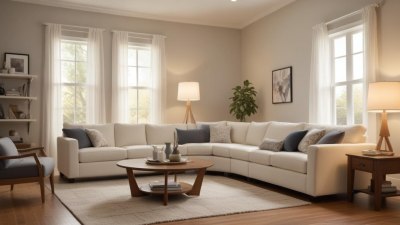Why People Rearrange Furniture with Changing Light and Temperature
Explore how shifting light and temperature affects furniture arrangement and home dynamics.

This image was created with the assistance of Freepik
Changing light and temperature throughout the seasons often prompts people to rearrange their furniture. This instinctive behavior goes beyond mere aesthetics; it reflects deeper psychological and environmental factors. In this article, we will explore why people choose to alter their interior spaces as seasons change, focusing on light dynamics, temperature fluctuations, and psychological well-being.
Understanding the Impact of Light
Natural light plays a crucial role in how we perceive our living spaces. During the longer days of summer, sunlight floods homes, creating a warm, inviting atmosphere. The arrangement of furniture can maximize this effect, enhancing brightness and warmth. Conversely, as the days grow shorter in winter, people tend to rearrange their furniture to optimize light sources. By moving pieces closer to windows or shifting layouts to avoid shadowy corners, individuals can create a more uplifting environment. This adaptability to light promotes a sense of comfort and well-being.
Temperature Changes and Comfort
Temperature is another key factor influencing furniture arrangement. As seasons shift, so too do the temperature fluctuations within homes. In winter, when heating systems are in use, people might rearrange furniture to prevent cold drafts from windows or to position seating around a fireplace. In contrast, during summer, when air conditioning is running, individuals may opt for layouts that enhance airflow and capitalize on cooler areas. These adjustments not only improve comfort but also contribute to energy efficiency, as homeowners develop intuitive strategies to maintain pleasant living conditions.
The Psychological Effect of Space
Psychologically, the way a home is organized plays a significant role in individual mood and mental clarity. A cluttered or poorly arranged space can lead to feelings of anxiety and stress. When people rearrange their furniture, they often find a renewed sense of control and purpose in their environment. This act of organizing can lead to improved mental health and emotional stability, particularly during transitional seasons when external conditions might be changing unpredictively.
Responding to Seasonal Changes
Human beings are inherently adaptive, and this trait extends to our living environments. As seasons change, so do our needs and activities. For instance, during spring and summer, families often gravitate towards outdoor entertaining. Rearranging indoor furniture to create storage for outdoor gear or reopening spaces for ease of flow can help adapt to these seasonal habits. Similarly, as fall approaches, individuals might focus on creating cozy, intimate spaces for gatherings and hibernation, thus facilitating the shift in lifestyle.
Creating Purposeful Spaces
With awareness of changing light and temperature, many people have become more intentional about their living spaces. Rearranging furniture can be an opportunity to rethink the function of each room. Rather than merely aesthetic changes, homeowners are finding ways to create multifunctional spaces that better suit their needs. For example, a previously neglected corner may be converted into a reading nook with the addition of a comfortable chair and lamp, utilizing warm light to foster relaxation.
The Aesthetic Aspect
While comfort and practicality are essential factors, the aesthetic appeal cannot be overlooked. People often rearrange furniture in response to changing seasons to create a visually stimulating environment. Seasonal colors, textures, and décor can be enhanced or minimized through strategic furniture placement. In spring, light pastels may take center stage, while deep hues may dominate during autumn. This aesthetic transition not only revitalizes a home but also brings awareness to the cyclical nature of life and seasonal change.
Social and Community Factors
It's not just individuals making these adjustments; social and community influences also play a role. The desire to keep up with home design trends or to host seasonal gatherings can spur furniture rearrangements. Offline and online communities often share tips and inspirations for home design, encouraging more people to actively rethink their spaces in relation to seasonal changes. As social creatures, we naturally respond to these trends and influences, seeking approval and connection through our living environments.
The Role of Technology
Technology has further broadened the ways people conceptualize their spaces. Virtual tools allow homeowners to create 3D layouts of their rooms and visualize different furniture arrangements before physically moving anything. This aspect makes rearranging less of a chore and more of a fun, engaging activity. Additionally, smart home technology can adapt light and temperature settings according to individual preferences, substantially influencing furniture layout and arrangement in real-time.
The Environmental Influence
As climate change prompts shifts in weather patterns, the awareness surrounding light and temperature's influence on living spaces becomes increasingly important. Homeowners can no longer ignore the effects of excessive heat or cold on comfort. As sustainable practices gain popularity, adjusting furniture arrangements can lead to optimal energy use, aiding conservation efforts while enhancing personal comfort. This adaptation might also involve selecting eco-friendly materials and practices in home design, aligning with a broader societal shift towards sustainability.
Benefits of Rearranging Furniture
Rearranging furniture provides various benefits, including increased functionality, enhanced aesthetic appeal, and improved emotional well-being. The process of transforming a space can lead to new routines, improving interpersonal relationships within households. When family members collaborate on a furniture layout, this collective effort can foster shared experiences and strengthen connections. Moreover, staying connected to the changing environment by reshaping spaces encourages mindfulness, prompting individuals to appreciate their surroundings. This practice can be particularly helpful during periods of change or uncertainty.
Implementing Changes
Those considering rearranging their furniture in response to changing light and temperature should approach the task with an open mind. Begin by observing the natural light patterns at different times of day and during various seasons. Take note of how you interact with your space and identify areas that feel stagnant or uninspired. This awareness will serve as a foundation for meaningful changes. When choosing a new layout, consider the flow of movement and accessibility, ensuring that the space feels inviting rather than cluttered.
The act of rearranging furniture in response to changing light and temperature is a reflection of human adaptability, creativity, and the innate desire for comfort. By embracing these seasonal changes, individuals can create spaces that are not only functional but also resonate with personal emotions and aesthetic preferences. Ultimately, these rearrangements allow us to forge deeper connections with our environments, contributing to heightened happiness and well-being. So as the seasons shift outside your window, consider how a small change inside might illuminate your living space in delightful new ways.











